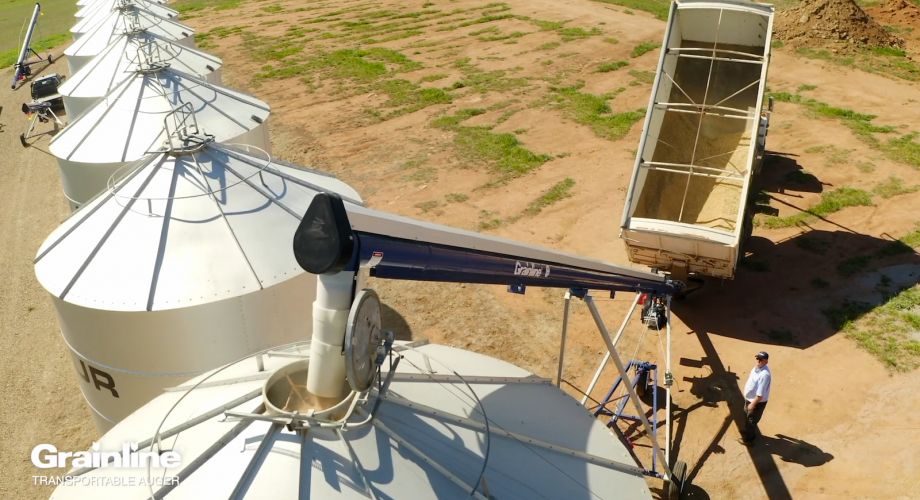What Grain Auger is most economical for your property?
Feb 17, 2020 Posted by Brittany Cunningham

Delmade offers the Grainline Auger, an Australian made auger engineered to perform. These augers are available in a large range of configurations including PTO, Hydraulic & Petrol Transport Augers and Mini mobile Augers. With such a large range available it can be difficult to work out which Grain Auger is right for your property. Don't worry Delmade has prepared a step by step guide to help you purchase a specialised Auger for your needs.
There are three important questions to answer. This will help you determine the most economical option for your property. Download the Answer Sheet and fill in your answers as you work through the guide.
- What length will I need?
- What capacity do I require?
- What power source will be the most economical?
Let's consider each question on its own.
WHAT LENGTH?
Grainline.jpg)
To calculate the length, two known factors must be established or known.
1. The maximum height the Auger is required to reach. This will generally be your silo height from the ground level.
IMPORTANT: If your ground level slopes away or rises, you must take this into account in your calculations.
2. The desired angle of operation. The acuteness of the angle affects capacity and power requirements and therefore, needs careful consideration. Let us look at the graph below.
Graph: Capacity vs Angle and Power

It will be seen that the angle affects capacity and power. The graph shows that capacity continues to decrease as angle increases, while power flattens out before falling. For practical purposes, the most suitable angles are between 30° and 35°, 32.5° is considered the optimal angle.
3. Let us now assume that we have two answers, height and angle. We can now calculate length. A simple formula can be used. Height in either meters or feet x 60 then divided by the chosen angle. Alternatively use the quick calculator below. Once you have calculated your length enter it on the answer sheet you downloaded.
Click here to use our handy auger length calculator.
WHAT CAPACITY?
Having already decided on the required angle in order to answer Question 1, There is very little option on an 8" Auger, except to increase or decrease flight RPM. The graph below shows how capacity changes with RPM or flight. But damage to grain and increased vibration will result from speeds much over 500 RPM.
GRAPH: FLIGHT RPM VS CAPACITY AT 35°

From the above graph, we can see that a Grainline Auger at 35° angle has a capacity of over 90 tons per hour at flight speed over 500 RPM.
IMPORTANT: Engine speed and belt slippage will directly affect capacity. The figures are only a guide due to various degrees of variance.
When you know the capacity required to satisfy your needs, circle it on the answer sheet you downloaded.
REMEMBER: Delmade has a wide range of Augers, starting from 4" upwards.
POWER SOURCE
An important decision to make is the method or means to operate the Auger. There are four options available:
- Petrol drive engine mounted Auger
- Tractor's power take-off (PTO) shaft
- Tractor's external hydraulics using remotes
- Electrical motor - not discussed in this guide please call Delmade on 1800 335 623 to discuss this option
For every meter of Auger length 1kw of power is required (2.5ft per 1 HP).
Taking the example of a 12.9m Auger, we can assume that a power requirement of 13kw is needed.
Careful consideration must be given to this important drive feature of an Auger. Let us consider the advantages and disadvantages of various drive options.
1. Petrol Engine: The auger is fitted with a petrol engine and dedicated to the Auger only.
- Auger is self-contained
- Not dependent on other farm machinery
- Highly maneuverable
- Low fuel consumption
- Electric winch as an option
- Engine servicing required
- Battery maintenance required
- Not reversible
2. Tractor's PTO: The auger is fitted with 1 3/8" x 6 splined shaft and gearbox driven via twin V belts
- Increase the versatility of tractor
- Lower Auger maintenance
- Reversible
- Lower capital outlay
- Reliability of tractor
- Availability of tractor
- The positioning of the tractor is important (especially when Augering out of a silo)
- Fuel consumption
3. Tractors Hydraulic System: The Auger is fitted with a hydraulic motor mounted on the top end of the Auger.
- Ultra-smooth running
- Very low Auger maintenance
- Increase the versatility of tractor
- Lower tractor RPM required
- The positioning of the tractor not critical
- Reversible
- Less capital outlay
- Heigh degree of maneuverability
- Reliability (minimal moving parts)
- Availability of tractor
- Suitability of hydraulic oil flow rates (40 L min)
After you have decided the most suitable source of power, fill in the answer on the downloaded answer sheet.
Congratulations you have now worked through Delmades three-step auger purchasing guide! Now you know exactly what type of auger you need simply give us a call on 1800 335 623 or email a copy of your answer sheet to info@delmade.com.au. We would love to talk over your decision and quote you up on the right auger for your property.
Didn't manage to find the auger you need? Don't worry this guide only covers our most popular auger ranges. If you have a requirement not listed here simply give us a call on 1800 335 623 and we can talk you through the full range available.
Interested in a Grain Auger? Check out the specs below or give us a call on 1800 335 623.
We would love to hear from you!
Please contact us at:
Delmade Pty Ltd
Phone: 1800 335 623
Email: info@delmade.com.au
